Abstract
This study proposes a novel finite control set model predictive control strategy (FCS-MPC) to suppress common-mode voltage (CMV) in electric propulsion systems while maintaining current quality. The key innovation is a virtual multi-vector synthesis method that eliminates zero-voltage vectors by adaptively generating small and medium vectors based on the modulation index and voltage sector. Unlike conventional CMV-reduction methods that compromise current quality or rely on fixed switching states, the proposed method enhances voltage resolution without relying on zero vectors. Simulation results demonstrate that, compared to conventional MPC, the proposed method reduces the CMV from approximately 100 V to 33 V—a 66.7% reduction. In terms of current quality, it achieves a 22.0% reduction in total harmonic distortion (THD) compared to the conventional reduced-CMV MPC method under low modulation conditions, while avoiding its excessive switching frequency. Experimental validation confirms both stable waveform generation and robust CMV suppression, while the proposed MPC reduces DSP execution time from 30.88 μs to 22.71 μs, thereby increasing computational availability to 77.3% and enabling real-time implementation on low-cost hardware. These results confirm the practicality of the proposed controller for real-time marine propulsion systems requiring both electromagnetic compatibility and high current quality.
1. Introduction
In the face of growing environmental concerns and high operating costs of conventional engines, electric propulsion systems have emerged as a viable alternative in the maritime industry. The urgent demand for decarbonization and improved energy efficiency has accelerated the adoption of these systems. In response, the International Maritime Organization (IMO) has introduced the Energy Efficiency Design Index (EEDI), which mandates a phased reduction in CO2 emissions per transport task. In particular, Phase 3 of the EEDI, which comes into force from 2025, requires a 30% reduction in CO2 emissions compared to Phase 2 [1].
Ships with electric propulsion vessels offer several advantages, including lower fuel consumption, lower emissions, and better energy efficiency owing to fewer energy conversion stages. By reducing dependence on fossil fuels, these systems contribute to lower greenhouse gas emissions and lower operating costs [2]. In addition, technological advances in high-efficiency batteries and fuel cell-based energy storage systems have facilitated the integration of renewable energy sources such as solar, wind, and hydrogen [3].
A typical electric propulsion system consists of a power generation unit, power conversion stage, and propulsion drive. In a power conversion system, the inverter plays a crucial role in converting DC into AC to drive the propulsion motors. It regulates both the voltage and the frequency, enabling precise control of the motor torque and speed. Consequently, the performance of the inverter has a direct effect on the propulsion efficiency, responsiveness, and overall power quality of the vessel.
However, a major challenge in the operation of inverters is the generation of common-mode voltage (CMV) between the power lines and ground during switching operations. CMV can induce leakage currents through capacitive paths such as between the motor shaft and ground, which can lead to insulation breakdown and degradation of electrical components within the power system [4,5]. It can also increase currents in the motor bearings, leading to bearing damage and shortening the service life of the motor [6,7,8,9]. In addition, CMV is a major source of electromagnetic interference (EMI) that can disrupt nearby electronic systems. In marine environments, EMI is crucial for ensuring the reliable operation of the system, as interference can affect sensitive onboard electronics and communication systems. To mitigate such interference, additional filtering is often required, which can cause additional power losses and increase the total harmonic distortion (THD) of the load current [10,11,12,13]. These problems significantly impair system reliability and increase maintenance demands in marine environments.
Therefore, mitigating the CMV in inverter-based electric propulsion systems is essential to ensure system reliability and power quality. Hardware-based approaches often lead to higher system complexity and cost. A more effective and space-saving strategy is to improve the control algorithms. Various pulse width modulation (PWM) techniques have been proposed for CMV reduction; however, their complexity and limited adaptability to different operating conditions limit their practical application [14,15,16,17,18,19,20].
Recently, finite control set model predictive control (FCS-MPC) has attracted attention owing to its simple structure, rapid dynamic response, and ability to deal with multiple constraints. The FCS-MPC determines the optimal switching states by directly predicting the system behavior and selecting the most suitable voltage vector without the need for conventional PWM. This makes it particularly suitable for complex systems, such as those found in marine propulsion applications.
A straightforward method of suppressing CMV is to exclude zero-voltage vectors from the set of selectable switching states, as these vectors tend to generate the highest CMV. By restricting the control to six active voltage vectors that are not zero, the CMV can be reduced [21]. However, this constraint leads to increased current ripple, particularly under low-speed or light-load conditions.
To solve this problem, a method that synthesizes a virtual reference voltage vector using two active vectors during a sampling period was proposed by Kwak and Mun [22]. Although this approach improves voltage tracking, it causes higher switching losses and higher current ripple during low-speed operation owing to the frequent use of non-adjacent or opposing vectors. Further improvements were suggested in a study by Kwak and Mun [23], in which opposite vectors were precluded, and zero-voltage vectors were replaced with reverse-voltage vectors, taking into account the effects of dead time. While this reduces the CMV, it also narrows the choice of vectors, which can lead to an increase in current ripple and THD.
To strike a balance between CMV suppression and performance, Guo et al. suggested dividing the voltage vector plane into sectors and allowing limited use of asymmetric or non-adjacent vectors, which increases flexibility [24]. Similarly, Li et al. introduced a strategy to select two optimal vectors in each control cycle, one from the active region and the other from the zero region [25]. Another method by Tang et al. proposed the synthesis of the effect of zero vectors by combining four active vectors within one control period [26].
A different approach was presented by Monfared et al., who developed a model predictive control strategy with optimal switching sequences for a nested neutral point clamped (NPC) inverter [27]. This method significantly reduces CMV while ensuring high performance in multilevel inverter structures, although it requires high computational resources and is limited to specific topologies. Lastly, Bebboukha et al. proposed a CMV-aware model predictive current control method that incorporates a CMV cost term into the predictive function to simultaneously suppress CMV and maintain accurate current tracking in grid-connected inverters [28].
To provide a comprehensive overview of MPC strategies for CMV reduction, Table 1 summarizes key techniques along with their main principles, advantages, and limitations.

Table 1.
Comparison of MPC-based techniques for CMV reduction in three-phase inverters.
As shown, each MPC-based method offers a unique trade-off between CMV suppression, current quality, and implementation complexity, depending on system constraints and control priorities.
In addition to electrical performance, power converters for marine propulsion systems must operate reliably under harsh environmental conditions, including high humidity, salt exposure, temperature variations, and continuous mechanical vibration. These factors can accelerate insulation degradation, increase noise susceptibility, and limit long-term operational stability. Moreover, the stringent EMI requirements onboard ships further constrain the converter design. To address these challenges, this study proposes a structurally simplified MPC-based control method that eliminates zero-voltage vectors, minimizes switching actions, and ensures stable execution on DSP hardware. These characteristics make the proposed method not only effective in suppressing CMV but also inherently robust and practical for long-term marine applications.
In this study, an improved method for CMV reduction based on finite control set model predictive control was proposed. The method aims to minimize the CMV while reducing the current ripple and maintaining low computational complexity, thereby improving the real-time applicability in marine inverter systems.
The main contributions of this study are as follows:
- Introducing a zero-vector-free MPC strategy using virtual vector synthesis.
- Achieving CMV suppression without output performance degradation.
- Maintaining low computational complexity suitable for real-time marine applications.
The article is organized as follows: Section 1 outlines the background and objectives of the study. Section 2 provides a review of conventional CMV reduction techniques. Section 3 introduces the proposed improvement methods. Section 4 presents comparative analyses through simulation and experimental validation, respectively. Finally, Section 5 concludes the paper with a summary of the findings and future work directions.
A list of abbreviations and nomenclatures used in this paper is summarized in Table 2.

Table 2.
List of abbreviations and nomenclatures.
2. Conventional Model Predictive Control
2.1. Three-Phase Voltage Source Inverter
Three-phase voltage source inverters (VSI) play a crucial role in power conversion systems and usually use IGBTs as switching devices. Each phase consists of a pair of complementary switches. When the upper switch is ON and the lower switch is OFF, the switching state is denoted as ; otherwise, , where .
Figure 1 illustrates the topology of a conventional two-level VSI. In such a VSI, eight switching combinations are possible, resulting in eight distinct voltage vectors as depicted in Figure 2. Among these, six are active (non-zero) vectors () that generate line-to-line voltages that can be used to control the direction and magnitude of the load current. The remaining two are zero-voltage vectors (), which do not affect the load voltage, but can influence the CMV.

Figure 1.
Three-phase voltage source inverter topology.
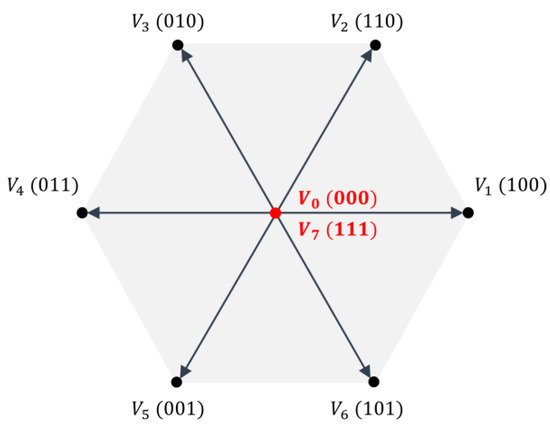
Figure 2.
Voltage vectors in three-level voltage source inverter.
To simplify the control algorithm and reduce the computational effort, the three-phase currents in the abc frame are typically transformed into a two-axis stationary reference frame using the Clarke transformation:
The motor load was modeled as a linear RL circuit with resistance , inductance , and back electromotive force (EMF) . The continuous-time current dynamics in the frame is expressed as
Assuming that the motor parameters and EMF remain approximately constant over a short sampling period, this equation is discretized using the forward Euler method to predict the current at the next sampling instant.
The discrete-time formulations of Equations (2) and (3) result in the following predictive equations:
Here, is the load current at the current sampling time, and is the predicted load current at the next step. This prediction was used to evaluate the voltage vectors in question and to select the optimal vector.
2.2. Model Predictive Control
In the conventional MPC strategy, the controller evaluates the cost function for all possible voltage vectors in each sampling interval and selects the voltage vector that minimizes the tracking error with respect to the reference current. The block diagram of the conventional MPC is shown in Figure 3.
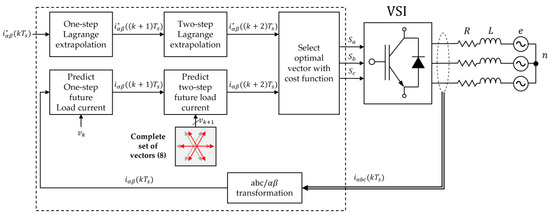
Figure 3.
Block diagram of the conventional MPC.
In this diagram, the control structure of the MPC method is illustrated, where the controller computes the cost function for all voltage vectors and selects the optimal one based on the prediction of the load current. The cost function, which is used for this optimization, is defined as follows:
where represents the reference load current at the next time step. The voltage vector that minimizes the error between the reference load current , calculated using Equations (4), and the predicted load current is selected. The reference current in the next time step was predicted using Lagrange extrapolation, as follows:
Owing to the inherent computational delay in the controller, the actual application of the selected switching state may occur one step after prediction. To solve this problem, a delay-compensation algorithm is used that applies the selected switching state after a subsequent sampling instant [29]. The predicted load current at time step is obtained by shifting the load model (Equation (4)) forward in one step, as follows:
Similarly, the reference load current at time step is predicted by shifting the reference current model (Equation (6)) forward in one step, as follows:
As the back electromotive force (EMF) typically varies slowly with respect to the sampling interval , the back EMF at time can be approximated as
With this compensation of the control delay, the revised cost function becomes
Using the delay-compensated cost function, all candidate voltage vectors were evaluated, and the voltage vector that minimized the error was selected and applied in the next switching period.
2.3. Reduced Common-Mode Voltage MPC
Although the conventional MPC offers advantages such as a simple control structure and fast dynamic response, it also has its limitations in that zero-voltage vectors may be selected. As shown in Table 3, when a zero-voltage vector is selected, the CMV increases to , leading to increased bearing currents, insulation stress, and EMI.

Table 3.
Common-mode voltage based on switching states of a three-phase inverter.
To mitigate these effects, an approach is proposed that excludes the use of zero-voltage vectors and considers only six active-voltage vectors. However, restricting the selection to active vectors may degrade the current quality owing to the reduced degrees of freedom, especially under low-load conditions. To address this limitation, a modified strategy was developed in which two active vectors are applied within each sampling period to approximate the reference voltage vector. This approach, known as reduced common-mode voltage MPC (RCMV-MPC), improves output performance while still suppressing the CMV. The control structure of this method is shown in Figure 4.
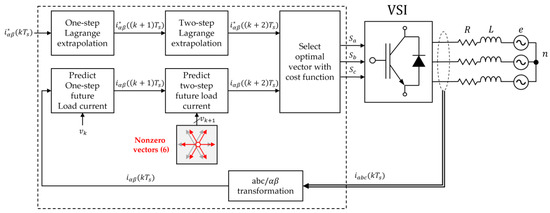
Figure 4.
Block diagram of the RCMV-MPC.
While this method improves current control under normal load conditions, it remains limited under low-load conditions, where the absence of zero-voltage vectors can compromise output stability. In such cases, increased THD and degraded current quality are observed.
Figure 5 illustrates the impact of this limitation by comparing the current tracking characteristics of the conventional MPC and the RCMV-MPC. In this figure, the gray arrows represent the candidate voltage vectors evaluated during the optimization process. Among them, the red and blue lines represent the current trajectories produced by applying two active voltage vectors sequentially within a sampling period—each for durations T1 and T2, respectively—whereas the green line corresponds to the conventional MPC using a single vector. As shown, the RCMV-MPC approach introduces noticeable current ripple due to the segmented approximation of the reference vector.
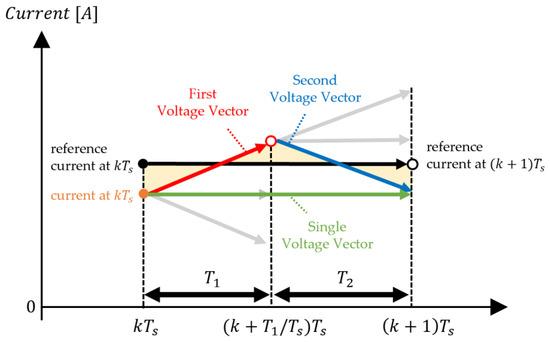
Figure 5.
Increased current ripple in RCMV-MPC due to segmented vector application.
Therefore, to maintain both CMV suppression and high-quality current output, it becomes necessary to not only optimize the selection and timing of voltage vectors but also incorporate ripple-mitigation strategies tailored for dynamic and low-load conditions.
3. Proposed Virtual Multi-Vector Based RCMV-MPC
Although conventional CMV reduction techniques have their merits, they often encounter performance tradeoffs, especially under light-load conditions. To overcome these limitations, a novel control method based on virtual multi-vectors is presented in this paper. The key innovation of the proposed strategy lies in the dynamic synthesis of virtual vectors using both sectoral decomposition and modulation index(MI)-based decision logic.
Unlike previous dual-vector MPC methods that use vector pairs within a control period, the proposed method introduces a structured, MI-aware synthesis sequence that generates small and medium vectors tailored to the operating condition. This approach enables more precise voltage generation while maintaining zero-vector-free operation.
In addition, the proposed method improves voltage resolution and switching flexibility by expanding the switching set through structured combinations of conventional active vectors, without increasing computational complexity. The overall control structure is illustrated in Figure 6.
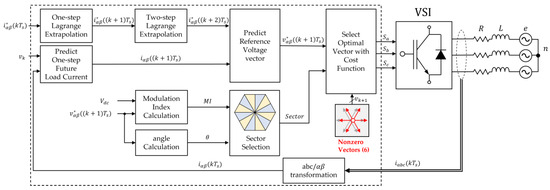
Figure 6.
Block diagram of the proposed RCMV-MPC.
Figure 7 illustrates the space vector plane and the selectable regions of each voltage vector in the proposed MPC. In addition to the six conventional vectors , indicated in red, twelve newly synthesized virtual vectors were included: six small vectors and six medium vectors , indicated in yellow and green, respectively. These virtual vectors are synthesized by combining conventional active voltage vectors in different directions, which enables fine-grained voltage regulation and reduces the slew rate of the voltage. The dashed circle marks the modulation index boundary at 0.5, which affects the synthesis method of small virtual vectors depending on the MI value. Additionally, three arrows adjacent to each small vector illustrate the sub-vectors synthesized to emulate a zero-voltage effect, contributing to CMV suppression.
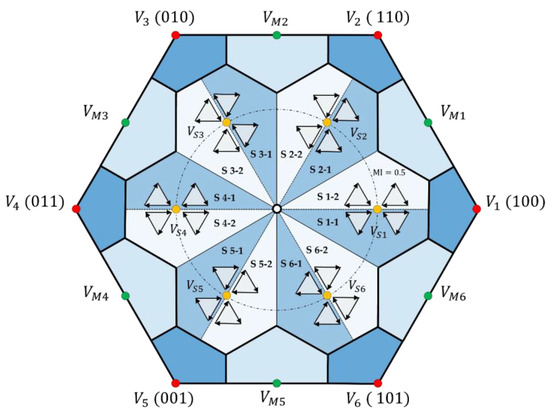
Figure 7.
Voltage vector diagram of the proposed MPC.
When a medium vector is selected, it is synthesized by applying two adjacent active voltage vectors for equal durations of , ensuring directionality and voltage balance. In contrast, when a small vector is selected, the corresponding active voltage vector is applied first for , followed by the sequential application of three active vectors emulating the effect of a zero-voltage vector during the remaining half of the sampling period. This vector-splitting strategy allows for more precise voltage generation while suppressing CMV more effectively.
In contrast to the conventional MPC approach, which uses a current-based cost function, the proposed MPC adopts a voltage-vector-based cost function for a more precise selection of switching states [30]. The cost function is defined based on the error between the reference and candidate voltage vectors as follows:
Here, and denote the α- and β-axis components of the reference voltage vector, respectively, which are calculated using the inverse dynamic model derived from the RL load equations.
Assuming that the reference current changes slowly compared to the sampling period, is approximated as and similarly for the β-axis. This assumption is valid in most MPC schemes, as the reference current typically exhibits a much lower frequency than the switching frequency.
Based on this, the reference voltage components are calculated as follows:
These predicted reference voltages are then compared with the actual voltages corresponding to each candidate switching state, and the one that minimizes the cost function is selected.
The proposed MPC, which does not directly use zero-voltage vectors, represents a novel approach to reduce the CMV by synthesizing voltage vectors. When a low voltage is selected, it must be synthesized using a combination of active voltage vectors. For example, the combinations V2, V4, V6, V1, V3, and V5 can emulate the effects of a zero-voltage vector. However, as the resulting voltage error depends on the sequence of the combinations, an optimized synthesis strategy is essential to minimize the error.
In the proposed approach, the optimal vector synthesis sequence is determined for the sectors of the reference voltage vector and the MI. The space–vector plane was divided into six sectors, each 60° apart. A voltage angle between −30° and 30° corresponds to sector 1, the remaining sectors were defined sequentially in increments of 60°. Each sector was further subdivided into two subsectors at intervals of 30°. The synthesis method depends on the specific sector and subsector of the reference vector whose angle is calculated as follows:
In addition, the MI influences voltage error and determines the synthesis strategy. The MI was calculated from the predicted reference voltage vector in Equations (12) and (13) as follows:
Here, denotes the magnitude of the predicted inverter reference voltage vector in the space–vector plane. The MI was normalized to the maximum output voltage of a two-level three-phase inverter, , and used as a criterion for vector selection.
Figure 8 illustrates how the small vector in sector 1 is synthesized depending on the MI value. In the figure, the dark blue arrow represents the first active voltage vector while the light blue arrows indicate the subsequent vectors synthesized to emulate a zero-voltage vector. As shown in Figure 8a,b, the optimal synthesis sequence is V5-V3-V1 when the predicted reference voltage is in sector 1-1 and MI 0.5, resulting in the smallest voltage error. If MI 0.5, the reverse sequence V1-V3-V5 is preferred. Similarly, for sector 1-2 shown in Figure 8c,d, the vector is synthesized as V4-V2-V6 when MI 0.5 and as V2-V6-V4 when MI 0.5. By varying the vector synthesis sequence according to the sector and MI, the voltage error could be minimized, allowing for more accurate control. The complete synthesis strategies for all sectors and MI ranges are summarized in Table 4.

Figure 8.
Zero voltage vector synthesis sequence based on modulation index in sector 1. (a): sector 1-1, MI 0.5; (b): sector 1-1, MI 0.5; (c): sector 1-2, MI 0.5; (d): sector 1-2, MI 0.5.

Table 4.
Selection of voltage vector by sector for zero-voltage vector synthesis.
To clearly summarize the differences between conventional MPC-based CMV reduction methods and the proposed approach, a structured comparison is provided below:
- Vector selection strategy:
Conventional methods employ fixed vector sets, such as predetermined active or reverse vectors. The proposed method selects candidate vectors adaptively based on the voltage sector and MI.
- Zero-vector handling:
Conventional methods either eliminate or replace zero-voltage vectors. The proposed method emulates their effect through synthesized combinations of small and medium active vectors without explicitly using zero vectors.
- Voltage resolution and tracking accuracy:
Conventional methods offer limited resolution due to coarse vector sets. The proposed method improves voltage resolution and reference tracking by flexibly combining multiple vectors depending on the modulation condition.
- Current quality (ripple and THD):
Conventional methods may produce higher ripple and distortion under light-load or low-MI conditions. The proposed method mitigates these effects by adapting vector orientation and magnitude.
- Switching frequency and implementation complexity:
Conventional methods may require either high switching frequency or compromise on output performance. The proposed method achieves a balance by using predefined vector tables, resulting in moderate switching with low complexity.
- Computational burden:
Conventional methods evaluate a wide range of vector candidates, increasing processing load. The proposed method restricts the number of evaluated candidates to 2–3 per sector, reducing logic complexity and execution time.
4. Simulation and Experimental Results
4.1. Simulation Results
Simulations were performed using the PSIM platform to validate the performance of the proposed Virtual Multi-Vector (VMV) MPC method. The simulations included steady-state and transient operations, with the primary objective of quantitatively comparing the performance of current-tracking and CMV reduction. Particular attention was paid to the evaluation of the output current quality and CMV suppression capabilities relative to conventional methods.
Two conventional control methods are used for comparison. The first is a typical MPC strategy that uses all possible switching states in a two-level inverter, including six active and two zero-voltage vectors. The second method aims to reduce the CMV by excluding the zero-voltage vectors and using only six active vectors. Although the latter method effectively suppresses the CMV, it suffers from a degradation in the quality of the output current.
The DC input voltage was set to Vdc = 200 V, and the load was modeled as an R-L circuit with R = 1.2 Ω and L = 9.872 mH. The reference load current under the steady-state conditions was 15 A. A three-phase, two-level inverter was used with the switching strategy adjusted for each control method. The sampling period was fixed at 00 μs. The main simulation parameters are listed in Table 5.

Table 5.
Simulation parameters.
The comparative evaluation included a comprehensive analysis of the tracking performance of the three-phase load current, a-phase load voltage, line-to-line voltage waveforms, CMV waveforms, and output current. This thorough analysis confirms that the proposed MPC outperforms the conventional strategies by simultaneously minimizing the CMV and improving the output waveform quality, providing a robust validation of its effectiveness.
Figure 9 compares the three MPC methods in steady-state operation at an MI of 0.8 and 60 Hz. The conventional MPC achieves accurate current tracking with a low THD of 2.12%. However, significant CMV fluctuations and high-frequency components were observed owing to the inclusion of zero-voltage vectors. In contrast, the conventional RCMV-MPC effectively suppresses CMV by eliminating zero vectors, resulting in the smothering of CMV waveforms and lower switching frequency. However, the limited vector options resulted in degraded output current quality and an increased THD of 2.95%.
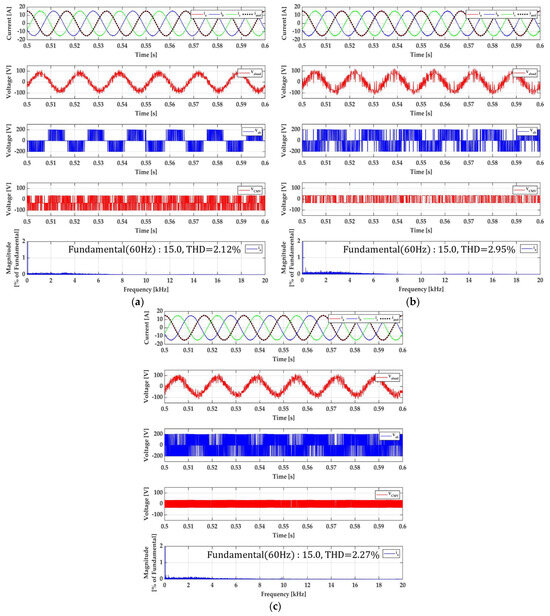
Figure 9.
Simulated waveforms of the three MPC methods in steady-state operation at MI = 0.8 and 60 Hz. The waveforms include the load current, a-phase load voltage, line-to-line voltage, common-mode voltage, and the frequency spectrum of the a-phase current. (a) Conventional MPC; (b) RCMV-MPC; (c) proposed MPC.
The proposed MPC combines the advantages of both the approaches. By synthesizing the active vectors, the effect of the zero vectors cannot be used directly. CMV remained at a level similar to that of RCMV-MPC, whereas the improved vector resolution improved the current quality and led to a reduced THD of 2.27%. These results highlight the effectiveness of the proposed MPC in mitigating the CMV and demonstrate its practicality in generating high-quality output waveforms, which are essential for the reliable and efficient operation of power electronic systems.
Figure 10 illustrates the performance of the three MPC methods at MI = 0.45 and 60 Hz, where low modulation requires more frequent use of zero-voltage vectors. The conventional MPC again showed excellent current tracking (THD = 3.62%), but the CMV remained significantly high. The RCMV-MPC reduced the CMV but at the expense of output quality, with a THD of 5.36%. By using virtual vector synthesis, the method achieved a THD of 4.18% while maintaining waveform integrity and suppressing CMV. These results show that the proposed MPC can minimize performance degradation under low-MI conditions while effectively reducing CMV.
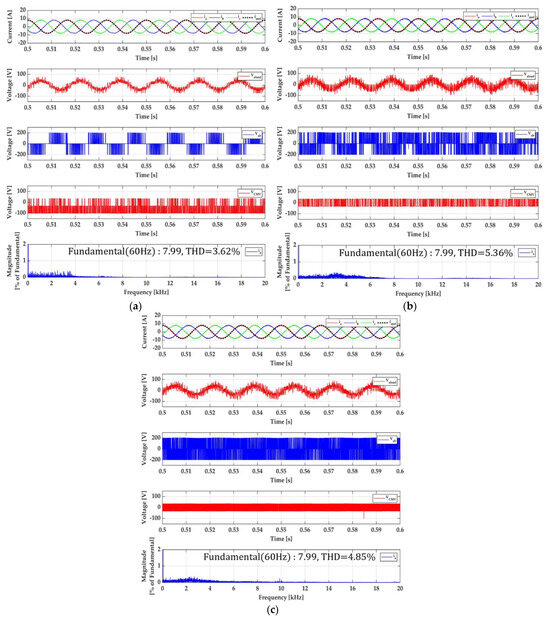
Figure 10.
Simulated waveforms of the three MPC methods in steady-state operation at MI = 0.45 and 60 Hz. The waveforms include the load current, a-phase load voltage, line-to-line voltage, common-mode voltage, and the frequency spectrum of the a-phase current. (a) Conventional MPC; (b) RCMV-MPC; (c) proposed MPC.
Figure 11 and Figure 12 show the performance when MI changes from 0.45 to 0.8 and when the frequency increases from 30 to 60 Hz, respectively. The conventional MPC maintains good current tracking but exhibits large CMV variations. The RCMV-MPC suppresses the CMV but shows degraded current tracking and waveform stability under rapid transitions.
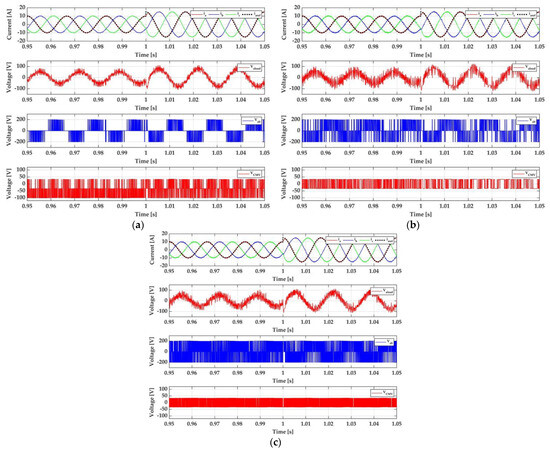
Figure 11.
Simulated waveforms of the three MPC methods in transition-state operation fromMI = 0.45 to 0.8 at 60 Hz. The waveforms include load current, a-phase load voltage, line-to-line voltage, and common-mode voltage. (a) Conventional MPC; (b) RCMV-MPC; (c) proposed MPC.
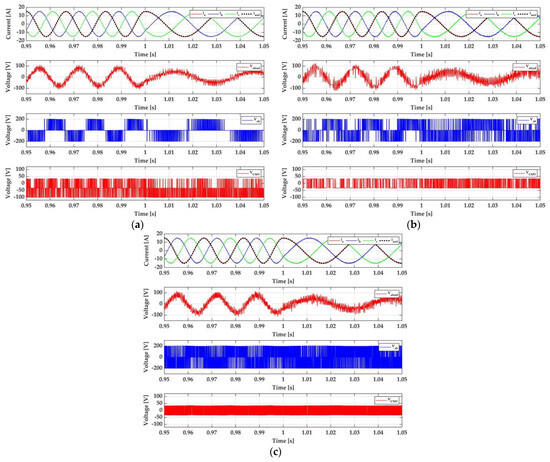
Figure 12.
Simulated waveforms of the three MPC methods in transition-state operation from 30 to 60 Hz at MI = 0.8. The waveforms include load current, a-phase load voltage, line-to-line voltage, and common-mode voltage. (a) Conventional MPC; (b) RCMV-MPC; (c) proposed MPC.
In contrast, the proposed MPC retains the fast response characteristics inherent in predictive control while maintaining low CMV levels. This is attributed to the flexibility of the virtual vector combinations, which enables the rapid selection of suitable vectors under dynamic conditions. Overall, the proposed MPC achieves a good balance between CMV suppression and output waveform quality under both steady-state and dynamic conditions.
Figure 13 compares the current-tracking error, THD, and CMV (RMS) at varying sampling frequencies. The conventional method shows better accuracy and lower THD at higher frequencies; however, the CMV remains the highest. The conventional RCMV method (conv-CMR) effectively suppresses the CMV but suffers from poor prediction accuracy, resulting in the highest errors and THD. The proposed MPC maintains a low CMV while achieving the current quality of the conventional method, especially when the sampling frequency exceeds 15 kHz. These results confirm that the proposed MPC effectively maintains the output quality while suppressing the CMV, even at practical control frequencies.
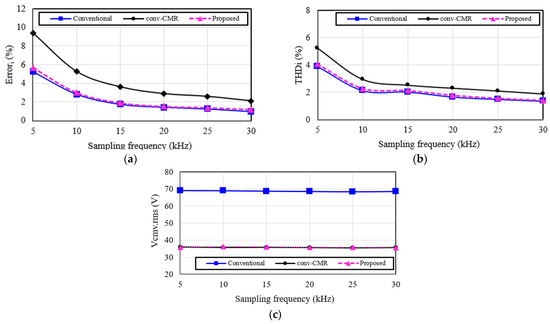
Figure 13.
Comparison of (a) output current error, (b) THD and (c) CMV (VCMV,rms) as a function of sampling frequency for three different MPC methods (conventional MPC, RCMV-MPC, proposed MPC).
Figure 14 shows a comparison of the three MPC methods in terms of MI. The conventional method has low error and THD but at the expense of high CMV. The RCMV method successfully suppresses CMV, but at the cost of a severe degradation in THD and errors, especially at lower MI values. In contrast, the proposed MPC strikes a balance by effectively controlling the current tracking and CMV at all MI levels. It ensures low CMV and THD, similar to those of the conventional method, thus ensuring effectiveness. Despite the increasing importance of zero-voltage vectors at low modulation indices (MI < 0.5), the proposed MPC successfully maintained better waveform quality without using them directly.
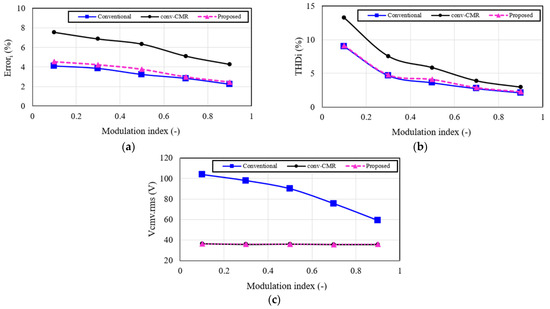
Figure 14.
Comparison of (a) current tracking error, (b) THD, and (c) CMV (VCMV,rms) as a function of modulation index for three MPC methods (conventional MPC, RCMV-MP{C, proposed MPC).
Figure 15 shows a comparison of the normalized switching numbers and efficiencies as a function of sampling frequency. The conventional method has the fewest switching events and the highest efficiency but at the expense of a high CMV. The RCMV method only ever uses active vectors, resulting in the highest number of switching operations and the lowest efficiency. The proposed MPC, which uses virtual vector synthesis, achieves a balance while maintaining a lower switching frequency than RCMV and better efficiency while still reducing CMV.

Figure 15.
Comparison of (a) normalized switching numbers and (b) efficiency as a function of sampling frequency for three MPC methods (conventional MPC, RCMV-MPC, proposed MPC).
Figure 16 presents a robustness analysis with respect to the mismatch in R and L. All predictive methods were affected by modeling inaccuracies; however, the inductance mismatch had a stronger effect on performance than resistance. RCMV-MPC showed considerable sensitivity to both inductance and resistance mismatch, leading to a notable drop in performance. This sensitivity can be attributed to its use of two voltage vectors within each switching period to improve current quality, which makes the control process more dependent on accurate prediction of current evolution. The proposed method, however, combines effective CMV suppression with strong robustness, showing better stability than RCMV-MPC. This robustness can be attributed to its use of a synthesized virtual vector that avoids zero-voltage vectors and does not depend strongly on exact parameter values, thereby making the method less susceptible to modeling inaccuracies. This suggests that the proposed strategy is well suited for practical applications where parameter uncertainty is inevitable, such as in marine propulsion systems.
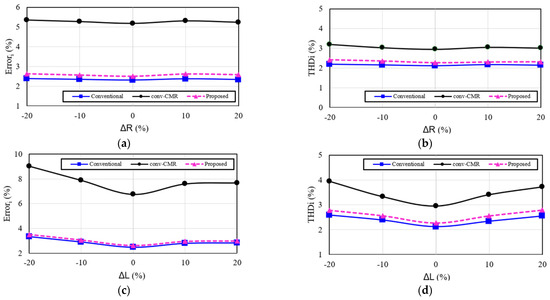
Figure 16.
Robustness analysis with respect to parameter mismatch in R and L for three MPC methods (conventional MPC, RCMV-MPC, proposed MPC): (a) Current error under R mismatch; (b) THD under R mismatch; (c) Current error under L mismatch; (d) THD under L mismatch.
In addition to the robustness against parameter mismatch, the proposed method was further evaluated under variations in inverter dead time, which is another critical non-ideal factor in practical converter systems. Dead time, introduced to prevent shoot-through faults in power switches, inherently causes output current distortion and degrades waveform quality, especially at low modulation indices or high switching frequencies.
To analyze this effect quantitatively, the dead time was varied from 0 to 15 μs, and the resulting trends in current tracking error and THD were observed. As shown in Figure 17, all three methods experienced performance degradation as the dead time increased. However, the proposed MPC consistently exhibited the smallest increase in both error and THD, indicating higher tolerance to dead-time-induced distortions.
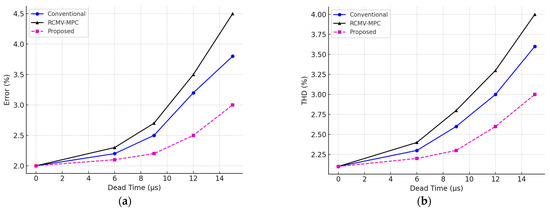
Figure 17.
Performance sensitivity to dead time variation for three MPC (conventional MPC, RCMV-MPC, proposed MPC): (a) Current tracking error; (b) THD.
This enhanced robustness is primarily due to two key design elements of the proposed method. First, the use of a predefined virtual vector structure avoids switching states that are most sensitive to dead-time effects. Second, the voltage-based cost function evaluates vector differences rather than relying on predicted current, which decouples the controller’s performance from the real-time accuracy of current prediction. This combination minimizes the propagation of dead-time errors into the control process and helps preserve waveform quality under non-ideal switching conditions.
These findings confirm that the proposed strategy not only handles parameter uncertainty but also maintains robust control under switching-related imperfections, further validating its applicability to real-world marine inverter systems.
Figure 18 and Figure 19 compare the CMV distributions at MI = 0.8 and MI = 0.45, respectively. The conventional MPC method shows a wide CMV distribution of up to 100 V, which raises concerns about EMI and electrical stress. The RCMV method concentrates the CMV around 33.33 V, effectively suppressing the high-voltage CMV. It significantly reduces the amplitude of CMV and eliminates high peaks such as −100 V without compromising the output voltage, which increases the precision of control.

Figure 18.
Distribution of CMV around representative voltage levels for three MPC methods in steady-state operation at MI = 0.8 and 60 Hz: (a) conventional MPC; (b) RCMV-MPC; (c) proposed MPC.

Figure 19.
Distribution of CMV around representative voltage levels for three MPC methods in steady-state operation at MI = 0.45 and 60 Hz: (a) conventional MPC; (b) RCMV-MPC; (c) proposed MPC.
To quantitatively assess the practical applicability of the proposed control strategy, this study conducted simulations not only with a R–L load but also under conditions that emulate a realistic marine propulsion system. Specifically, the load model was constructed based on the mechanical and electrical parameters of a 50 kW, 4-pole, 60 Hz induction motor. These parameters, summarized in Table 6, were estimated from actual operational data and are designed to reflect the physical characteristics of marine electric propulsion systems.

Table 6.
Simulation parameters of a 50 kW-class induction motor (4 poles, 60 Hz).
In typical propulsion environments, the load torque tends to vary with the square of the rotor speed (T ∝ ω2) due to hydrodynamic drag. Accordingly, the simulation incorporated a normalized speed–torque relationship derived from actual ship measurements to accurately model such nonlinear load behavior.
Figure 20 illustrates the performance of the proposed control strategy under a realistic marine propulsion scenario characterized by continuous changes in speed and load. This test was designed to emulate typical ship operation conditions, such as acceleration during departure, constant-speed cruising, and deceleration while docking, which inherently involve nonlinear load torque variations and dynamic disturbances.
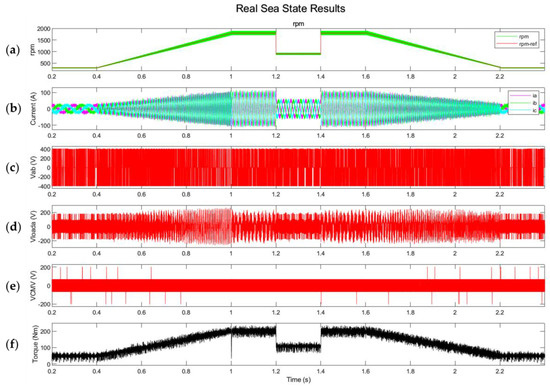
Figure 20.
Simulation results under realistic marine load profile: (a) rotor speed; (b) output current; (c) pole voltage; (d) line-to-line voltage; (e) CMV; (f) torque response.
The results confirm that the proposed MPC maintains stable current and voltage waveforms throughout the entire profile. In particular, the CMV remains well suppressed without introducing high-frequency noise or spikes, even during rapid speed changes. The torque response is smooth and continuous, showing no signs of oscillation or instability, which is essential for ensuring mechanical integrity in propulsion systems. The output current maintains good symmetry, and the line-to-line voltage remains sinusoidal, indicating effective switching and waveform control.
These findings clearly demonstrate the proposed controller’s robustness and adaptability in realistic marine operating conditions. Through stable waveform regulation, consistent CMV suppression, low torque ripple, and accurate current tracking under variable-speed and nonlinear load scenarios, the method proves to be a highly suitable and reliable solution for marine electric propulsion systems, where both electromagnetic compatibility and dynamic performance are critical.
4.2. Experimental Results
Figure 21 illustrates the experimental setup used to verify the effectiveness of the proposed MPC. A two-level VSI was used, with the control algorithm implemented on a digital signal processor (DSP) (TMS320F28335, Texas Instruments Inc., Dallas, TX, USA) operating with a sampling period of 100 μs. The DSP generated six gate signals to control the six IGBT switches of the two-level inverter. An AC generator in combination with a rectifier supplies a DC link voltage of 200 V. The inverter output was connected to a three-phase R-L load. The detailed system parameters are listed in Table 7.
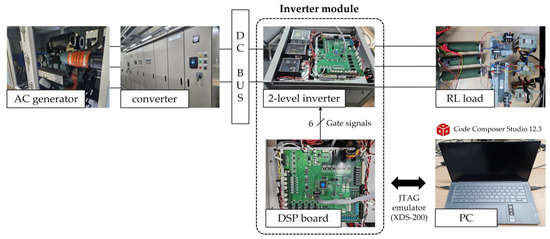
Figure 21.
Experimental setup.

Table 7.
Experimental parameters.
In this experiment, the proposed MPC method was compared with a conventional MPC method that did not consider the CMV. The CMV suppression-only method was excluded, as it offered limited improvements in overall performance. The comparison was based on measured quantities, including three-phase output currents, a-phase pole voltage, line-to-line voltage, and common-mode voltage.
The evaluation was conducted under two steady-state operating conditions: MI = 0.8 at 60 Hz, and MI = 0.45 at 60 Hz. As depicted in Figure 22, under the MI = 0.8 condition, the conventional MPC showed accurate current tracking with minimal ripple, but the CMV varied considerably, ranging from to . In contrast, the proposed MPC achieves a similar level of CMV suppression, while the current ripple was comparable to that of the conventional MPC.
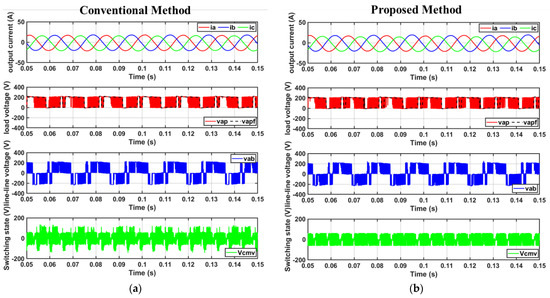
Figure 22.
Experimental steady-state waveforms of the three MPC methods at MI = 0.8 (Iload = 20 A) and 60 Hz. The waveforms include load current, a-phase load voltage, a-pole voltage, and line-to-line voltage, and common-mode voltage. (a) Conventional MPC; (b) proposed MPC.
Figure 23 shows that the conventional MPC still exhibits good current tracking under the MI = 0.45 condition; however, owing to the increased influence of the zero-voltage vectors, the CMV remained relatively high. In contrast, the proposed MPC achieved a favorable balance between CMV suppression and current quality even under this low modulation condition, highlighting its advantage in maintaining performance under constrained conditions.
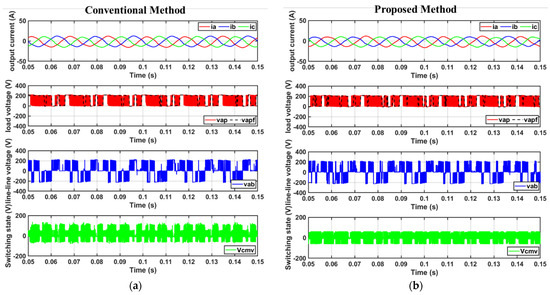
Figure 23.
Experimental steady-state waveforms of the three MPC methods at MI = 0.45 (Iload = 11 A) and 60 Hz. The waveforms include load current, a-phase load voltage, a-pole voltage, and line-to-line voltage, and common-mode voltage. (a) Conventional MPC; (b) proposed MPC.
Transient performance was also evaluated under two scenarios: a step change in the modulation index and a simultaneous change in frequency. Figure 24 shows the response of the system when the load current is increased from 5 A to 15 A and the frequency is decreased from 60 Hz to 30 Hz. The conventional MPC maintained a fast dynamic current response but resulted in considerable CMV fluctuations, similar to the range observed under steady-state conditions. In contrast, the proposed MPC provides both rapid current adaptation and stable CMV suppression, demonstrating its effectiveness in handling fast transitions.
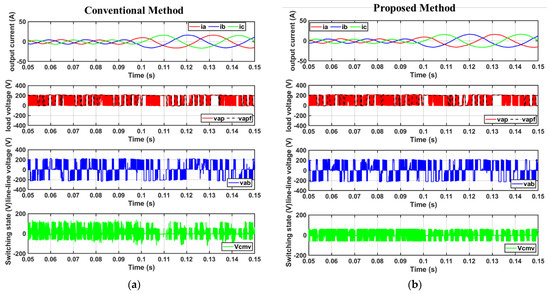
Figure 24.
Experimental waveforms of the three MPC methods in the transient state during a step change in current (5 A to 15 A) and frequency (60 Hz to 30 Hz). The waveforms include load current, a-phase pole voltage, line-to-line voltage, and common-mode voltage. (a) Conventional MPC; (b) proposed MPC.
The proposed control algorithm was developed with computational simplicity to ensure easy real-time implementation in DSPs. In particular, the selection of candidate voltage vectors is narrowed by using sector information and the MI, which enables early elimination of unnecessary switching states and excludes zero vectors entirely. This selective approach reduces the number of evaluations per control cycle and avoids redundant computations, resulting in lower computational load and faster execution within the sampling period. Such structural simplification enabled reliable real-time operation on a TMS320F28335 DSP, with experimental results confirming stable control within the sampling interval and no observable degradation in output performance. A detailed comparison of the execution times across different MPC schemes is provided in Table 8.

Table 8.
Comparison of DSP execution time, usage rate, and available computational time by control method.
As shown in Table 8, the proposed method achieves significant computational efficiency by reducing the DSP execution time, resulting in a higher percentage of available computational time. This is achieved through strategic simplifications, including sector-based virtual vector selection, which reduces the number of candidate vectors from 7 to 2–3, and optimization of the cost function calculation, which reduces the frequency of computations. Furthermore, the proposed approach ensures operational stability by relying on a fixed-path computation, which minimizes repetitive calculations. This allows for up to 77.29% of available DSP resources, suggesting that additional features such as sensor-less control and diagnostic algorithms can be added with ease.
To provide a comprehensive evaluation of the proposed control method, Table 9 summarizes the performance of three MPC strategies in terms of CMV suppression, current quality, and real-time feasibility. The proposed method demonstrates a balanced improvement across all metrics, combining effective CMV reduction with lower harmonic distortion and reduced computational cost.

Table 9.
Comprehensive comparison of three control strategies at MI = 0.8, 60 Hz.
Table 9 consolidates the main findings from both the simulation and experimental studies, presenting an overall comparison of three MPC strategies. The proposed method achieves a strong balance between CMV suppression, current quality, and computational efficiency. This confirms its practical potential for real-time applications where both electrical performance and control responsiveness are critical.
In addition to outperforming conventional approaches, the proposed method was also compared with a recently published multi-vector predictive strategy by Tang et al. (2024) [26], which introduces a different synthesis mechanism for CMV suppression. While that method achieves reasonable results, its reliance on multiple active vectors increases computational burden and switching complexity.
Table 10 highlights the key differences in structure, performance, and implementation feasibility between the two approaches. The proposed method provides superior CMV and THD reduction, along with low computational complexity and verified real-time implementation. This comparison further reinforces the method’s originality and robustness, particularly for marine inverter systems with strict EMI and reliability requirements.

Table 10.
Performance comparison with a recent multi-vector MPC method.
Taken together, the results from simulations, experiments, and comparative evaluations confirm that the proposed MPC strategy effectively balances CMV suppression, current quality, and real-time feasibility.
Overall, the simulation and experimental results verify that the proposed control strategy consistently reduces CMV by 65%, while achieving superior current quality across a wide range of operating conditions, including both steady-state and dynamic transients. Moreover, the controller maintains a low computational burden and short execution time, confirming its suitability for real-time embedded applications. These results confirm that the proposed method is not only theoretically robust but also practically suited for inverter-fed electric propulsion systems, where stringent requirements on electromagnetic compatibility and dynamic control performance must be simultaneously met.
5. Conclusions
This paper proposes an enhanced FCS-MPC strategy that effectively suppresses CMV without relying on zero-voltage vectors. The proposed method utilizes a virtual vector synthesis technique to eliminate zero-voltage vectors while ensuring minimal degradation of output performance. By employing sector-based vector selection and modulation index-dependent synthesis, the method improves switching flexibility and voltage resolution.
Simulation results confirm that the proposed strategy achieves CMV suppression comparable to conventional methods, while also improving current quality in terms of THD and tracking accuracy. The controller demonstrates robustness under various operational conditions, including low modulation index, sampling frequency variation, and parameter mismatches. However, the method still faces challenges in extreme low-load conditions, where current ripple can increase, which remains an area for future improvement.
The proposed approach, initially developed for marine electric propulsion systems, has shown significant potential for broader applications. For instance, in multilevel inverters, fuel cell-based propulsion systems, and hybrid electric drives, the method can offer enhanced performance by addressing the challenges of precise current control, low EMI, and robustness to environmental changes. While the method performs well in many scenarios, its computational complexity and response to rapid operational shifts in real-time systems may require further optimization, particularly under extreme environmental conditions.
Overall, the proposed control strategy provides a practical and reliable solution for CMV-sensitive applications, achieving superior electrical performance and real-time feasibility. However, further refinements, particularly in optimizing the handling of low-load conditions and computational efficiency, are necessary to fully realize its potential across a wide range of applications.
The main findings and contributions of this study are summarized as follows:
- A novel zero-vector-free MPC strategy is proposed based on virtual vector synthesis using voltage sector and modulation index.
- The method achieves a 66.7% reduction in CMV and a 22.8% reduction in current THD under low modulation index conditions.
- Simulation and experimental results confirm consistent performance across steady-state, transient, and parameter-mismatched conditions.
- The average DSP execution time is reduced to 22.71 μs, providing 77.3% available computation time.
- The approach ensures low switching frequency and computational complexity by reducing candidate vectors to 2–3 per sector.
- The method is suitable for real-time implementation and can be extended to multilevel inverters and other high-reliability applications.
Future research will focus on evaluating the influence of environmental conditions, such as temperature and vibration, on system stability and performance through experiments in marine environments. In addition, a comprehensive computational load analysis and DSP usage evaluation will be conducted to further validate the real-time applicability of the proposed method in practical scenarios. Furthermore, the investigation into system stability margins and the development of ripple-mitigation strategies under extreme operating conditions will be critical to further enhancing the robustness and reliability of the method.
Author Contributions
Methodology, C.R.; software, S.-w.S.; investigation, S.-w.S.; data curation, S.-w.S.; writing—original draft, C.R.; writing—review and editing, C.R.; supervision, C.R.; project administration, C.R. All authors have read and agreed to the published version of the manuscript.
Funding
This research was funded by the Ministry of Trade, Industry and Energy (MOTIE) and the Korea Evaluation Institute of Industrial Technology (KEIT), grant numbers RS-2024-00437087 and RS-2024-00432064.
Data Availability Statement
The original contributions presented in this study are included in the article. Further inquiries can be directed to the corresponding author.
Conflicts of Interest
The authors declare no conflicts of interest.
References
- Ančić, I.; Šestan, A. Influence of the required EEDI reduction factor on the CO2 emission from bulk carriers. Energy Policy 2015, 84, 107–116. [Google Scholar] [CrossRef]
- Nguyen, H.P.; Hoang, A.T.; Nizetic, S.; Nguyen, X.P.; Le, A.T.; Luong, C.N.; Chu, V.D.; Pham, V.V. The electric propulsion system as a green solution for management strategy of CO2 emission in ocean shipping: A comprehensive review. Int. Trans. Electr. Energy Syst. 2021, 31, e12580. [Google Scholar] [CrossRef]
- Liserre, M.; Sauter, T.; Hung, J.Y. Future energy systems: Integrating renewable energy sources into the smart power grid through industrial electronics. IEEE Ind. Electron. Mag. 2010, 4, 18–37. [Google Scholar] [CrossRef]
- Erdman, J.M.; Kerkman, R.J.; Schlegel, D.W.; Skibinski, G.L. Effect of pwm inverters on ac motor bearing currents and shaft voltages. IEEE Trans. Ind. Appl. 1996, 32, 250–259. [Google Scholar] [CrossRef]
- Moreira, A.F.; Lipo, T.A.; Venkataramanan, G.; Bernet, S. High-frequency modeling for cable and induction motor overvoltage studies in long cable drives. IEEE Trans. Ind. Appl. 2002, 38, 1297–1306. [Google Scholar] [CrossRef]
- De Broe, A.M.; Julian, A.L.; Lipo, T.A. Neutral-to-ground voltage minimization in a pwm-rectifier/inverter configuration. In Proceedings of the Sixth International Conference on Power Electronics and Variable Speed Drives (Conf. Publ. No. 429), Nottingham, UK, 23–25 September 1996; pp. 564–568. [Google Scholar] [CrossRef]
- Cacciato, M.; Consoli, A.; Scarcella, G.; Testa, A. Reduction of common-mode currents in pwm inverter motor drives. IEEE Trans. Ind. Appl. 1999, 35, 469–476. [Google Scholar] [CrossRef]
- Muetze, A.; Binder, A. Don’t lose your bearings. IEEE Ind. Appl. Mag. 2006, 12, 22–31. [Google Scholar] [CrossRef]
- Duran, M.J.; Riveros, J.A.; Barrero, F.; Guzman, H.; Prieto, J. Reduction of common-mode voltage in five-phase induction motor drives using predictive control techniques. IEEE Trans. Ind. Appl. 2012, 48, 2059–2067. [Google Scholar] [CrossRef]
- Chen, S.; Lipo, T.A.; Fitzgerald, D. Modeling of motor bearing currents in PWM inverter drives. IEEE Trans. Ind. Applicat. 1996, 32, 1365–1370. [Google Scholar] [CrossRef]
- Xie, Y.; Jiang, D.; Hu, F.; Liu, Z. Research on common mode EMI and its reduction for active magnetic bearings. IEEE Trans. Power Electron. 2023, 38, 4246–4250. [Google Scholar] [CrossRef]
- Wang, S.; Lee, F.C. Analysis and applications of parasitic capacitance cancellation techniques for EMI suppression. IEEE Trans. Ind. Electron. 2010, 57, 3109–3117. [Google Scholar] [CrossRef]
- Zhong, E.; Lipo, T.A. Improvements in EMC performance of inverter-fed motor drives. IEEE Trans. Ind. Appl. 1995, 31, 1247–1256. [Google Scholar] [CrossRef]
- Tian, K.; Wang, J.; Wu, B.; Cheng, Z.; Zargari, N.R. A virtual space vector modulation technique for the reduction of common-mode voltages in both magnitude and third-order component. IEEE Trans. Power Electron. 2016, 31, 839–848. [Google Scholar] [CrossRef]
- Cavalcanti, M.C.; de Oliveira, K.C.; Neves, F.A.S.; Azevedo, G.M.S.; Camboim, F.C. Modulation techniques to eliminate leakage currents in transformerless three-phase photovoltaic systems. IEEE Trans. Ind. Electron. 2010, 57, 1360–1368. [Google Scholar] [CrossRef]
- Kim, H.-J.; Lee, H.D.; Sul, S.-K. A new PWM strategy for common-mode voltage reduction in neutral-point-clamped inverter-fed AC motor drives. IEEE Trans. Ind. Appl. 2001, 37, 1840–1845. [Google Scholar] [CrossRef]
- Lakshminarayanan, S.; Mondal, G.; Tekwani, P.N.; Mohapatra, K.K.; Gopakumar, K. Twelve-sided polygonal voltage space vector based multilevel inverter for an induction motor drive with common-mode voltage elimination. IEEE Trans. Ind. Electron. 2007, 54, 2761–2768. [Google Scholar] [CrossRef]
- Lai, Y.S.; Shyu, F.S. Optimal common-mode voltage reduction PWM technique for inverter control with consideration of the dead-time effects—Part I: Basic development. IEEE Trans. Ind. Appl. 2004, 40, 1605–1612. [Google Scholar] [CrossRef]
- Kimball, J.W.; Zawodniok, M. Reducing common-mode voltage in three-phase sine-triangle PWM with interleaved carriers. IEEE Trans. Power Electron. 2011, 26, 2229–2236. [Google Scholar] [CrossRef]
- Chen, J.; Jiang, D.; Li, Q. Attenuation of conducted EMI for three-level inverters through PWM. CPSS Trans. Power Electron. Appl. 2018, 3, 134–145. [Google Scholar] [CrossRef]
- Hoseini, S.K.; Adabi, J.; Sheikholeslami, A. Predictive modulation schemes to reduce common-mode voltage in three-phase inverters-fed AC drive systems. IET Power Electron. 2014, 7, 840–849. [Google Scholar] [CrossRef]
- Kwak, S.; Mun, S.K. Model predictive control methods to reduce common-mode voltage for three-phase voltage source inverters. IEEE Trans. Power Electron. 2015, 30, 5019–5035. [Google Scholar] [CrossRef]
- Kwak, S.; Mun, S. Common-mode voltage mitigation with a predictive control method considering dead time effects of three-phase voltage source inverters. IET Power Electron. 2015, 8, 1690–1700. [Google Scholar] [CrossRef]
- Guo, L.; Jin, N.; Gan, C.; Xu, L.; Wang, Q. An improved model predictive control strategy to reduce common-mode voltage for two-level voltage source inverters considering dead-time effects. IEEE Trans. Ind. Electron. 2019, 66, 3561–3572. [Google Scholar] [CrossRef]
- Li, X.; Xie, M.; Ji, M.; Yang, J.; Wu, X.; Shen, G. Restraint of common-mode voltage for PMSM-inverter systems with current ripple constraint based on voltage-vector MPC. IEEE J. Emerg. Sel. Top. Ind. Electron. 2023, 4, 688–697. [Google Scholar] [CrossRef]
- Tang, X.; Yuan, X.; Niu, S.; Chau, K.T. High-efficient multivector model predictive control with common-mode voltage suppression. IEEE J. Emerg. Sel. Top. Power Electron. 2024, 12, 2674–2685. [Google Scholar] [CrossRef]
- Monfared, K.K.; Iman-Eini, H.; Neyshabouri, Y.; Liserre, M. Model predictive control with reduced common-mode voltage based on optimal switching sequences for nested neutral point clamped inverter. IEEE Trans. Ind. Electron. 2024, 71, 27–38. [Google Scholar] [CrossRef]
- Bebboukha, A.; Meneceur, R.; Chouaib, L.; Anees, M.A.; Elsanabary, A.; Mekhilef, S.; Bakeer, A.; Harbi, I.; Zaitsev, I.; Bajaj, M. Finite control set model predictive current control for three-phase grid-connected inverter with common mode voltage suppression. Sci. Rep. 2024, 14, 19832. [Google Scholar] [CrossRef] [PubMed]
- Cortes, P.; Rodriguez, J.; Silva, C.; Flores, A. Delay compensation in model predictive current control of a three-phase inverter. IEEE Trans. Ind. Electron. 2012, 59, 1323–1325. [Google Scholar] [CrossRef]
- Xia, C.; Liu, T.; Shi, T.; Song, Z. A simplified finite-control-set model-predictive control for power converters. IEEE Trans. Ind. Inform. 2014, 10, 991–1002. [Google Scholar] [CrossRef]
Disclaimer/Publisher’s Note: The statements, opinions and data contained in all publications are solely those of the individual author(s) and contributor(s) and not of MDPI and/or the editor(s). MDPI and/or the editor(s) disclaim responsibility for any injury to people or property resulting from any ideas, methods, instructions or products referred to in the content. |
© 2025 by the authors. Licensee MDPI, Basel, Switzerland. This article is an open access article distributed under the terms and conditions of the Creative Commons Attribution (CC BY) license (https://creativecommons.org/licenses/by/4.0/).